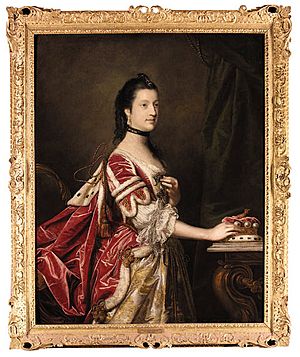Elizabeth Percy, Duchess of Northumberland (1716–1776) facts for kids
Quick facts for kids
The Duchess of Northumberland
|
|
|---|---|

Portrait by Sir Joshua Reynolds, c. 1761
|
|
| Lady of the Bedchamber | |
| In office 1761–1770 |
|
| Personal details | |
| Born | 26 November 1716 |
| Died | 5 December 1776 (aged 60) |
| Resting place | Northumberland Vault, Westminster Abbey |
| Spouse | |
| Children |
|
| Parents | |
| Occupation | Lady of the Bedchamber to Queen Charlotte |
Elizabeth Percy, Duchess of Northumberland (born Seymour; 26 November 1716 – 5 December 1776) was an important British noblewoman. She was also known as the 2nd Baroness Percy in her own right. This means she inherited a noble title directly, not through her husband.
Contents
Who Was Elizabeth Percy?
Elizabeth Percy was the only daughter of Algernon Seymour, 7th Duke of Somerset. Her mother was Frances Thynne. Elizabeth came from a very important and powerful family in Britain.
Her Marriage and Family Life
On 16 July 1740, Elizabeth married Sir Hugh Smithson. They had two sons together:
- Hugh (born 1742)
- Algernon (born 1750)
When Elizabeth's father passed away in 1750, she inherited his title, the barony of Percy. Her husband, Sir Hugh, also gained a new title from her father: the earldom of Northumberland. To show their connection to Elizabeth's family, Sir Hugh changed his last name from Smithson to Percy that same year.
A Famous Relative
Interestingly, Sir Hugh had an illegitimate son named James Smithson. James was born around 1764. He later left a large sum of money that helped create the famous Smithsonian Institution in the United States. This institution is a group of museums and research centers.
Elizabeth's Role at Court
In 1761, Elizabeth Percy became a Lady of the Bedchamber to Queen Charlotte. This was an important role, meaning she was a close attendant and friend to the Queen. She held this position until 1770.
In 1766, her husband was given the highest noble title, becoming the Duke of Northumberland. This made Elizabeth the Duchess of Northumberland. She passed away in 1776 at the age of sixty. Her noble titles then went to her eldest son, Hugh.
Remembering Elizabeth Percy
Elizabeth Percy was buried in the Northumberland Vault inside Westminster Abbey. This is a very famous church in London where many important British figures are buried. Her husband, who was very sad after her death, built Brizlee Tower to remember her. It was one of several monuments he created in her honor.
Her epitaph, a message carved on her tomb, described her as having "every amiable & benevolent virtue." It also said she was "an ornament of courts, an honour to her country, & patern to the great, a protectress of the poor." She was remembered for her "tender affection for her family & friends."
Elizabeth's Writings and Legacy
In 1775, a book was published anonymously called "A Short Tour made in the Year One Thousand Seven Hundred and Seventy One." This book was Elizabeth's diary about her travels in the Dutch Republic (modern-day Netherlands). It was lively, entertaining, and full of interesting historical information. Parts of her diary were published again in 1936.
Portraits and Public Image
The National Portrait Gallery has several mezzotints (a type of print) based on portraits of Elizabeth. These were made by the famous artist Sir Joshua Reynolds. Another watercolor portrait by Richard Gibson is kept at the Fitzwilliam Museum in Cambridge.
A writer named Horace Walpole described Elizabeth as a "jovial heap of contradictions." He noted that she was proud of her noble family but also friendly with common people. She loved grand events and crowds. She was very dedicated to the King and Queen, whom she called her "Master" and "Mistress." She even brought a larger group of servants to the theater than the Queen did! She also brought back old family traditions like drummers and pipers. Walpole described her as generous and friendly, even if sometimes a bit mischievous.

